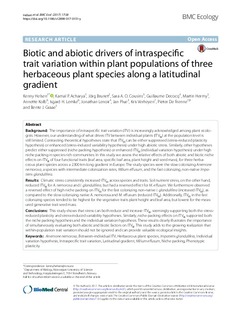| dc.description.abstract | Background: The importance of intraspecific trait variation (ITV) is increasingly acknowledged among plant ecologists. However, our understanding of what drives ITV between individual plants (ITVBI) at the population level is still limited. Contrasting theoretical hypotheses state that ITVBI can be either suppressed (stress-reduced plasticity hypothesis) or enhanced (stress-induced variability hypothesis) under high abiotic stress. Similarly, other hypotheses predict either suppressed (niche packing hypothesis) or enhanced ITVBI (individual variation hypothesis) under high niche packing in species rich communities. In this study we assess the relative effects of both abiotic and biotic niche effects on ITVBI of four functional traits (leaf area, specific leaf area, plant height and seed mass), for three herbaceous plant species across a 2300 km long gradient in Europe. The study species were the slow colonizing Anemone nemorosa, a species with intermediate colonization rates, Milium effusum, and the fast colonizing, non-native Impatiens glandulifera. Results: Climatic stress consistently increased ITVBI across species and traits. Soil nutrient stress, on the other hand, reduced ITVBI for A. nemorosa and I. glandulifera, but had a reversed effect for M. effusum. We furthermore observed a reversed effect of high niche packing on ITVBI for the fast colonizing non-native I. glandulifera (increased ITVBI), as compared to the slow colonizing native A. nemorosa and M. effusum (reduced ITVBI). Additionally, ITVBI in the fast colonizing species tended to be highest for the vegetative traits plant height and leaf area, but lowest for the measured generative trait seed mass. Conclusions: This study shows that stress can both reduce and increase ITVBI, seemingly supporting both the stress-reduced plasticity and stress-induced variability hypotheses. Similarly, niche packing effects on ITVBI supported both the niche packing hypothesis and the individual variation hypothesis. These results clearly illustrates the importance of simultaneously evaluating both abiotic and biotic factors on ITVBI. This study adds to the growing realization that within-population trait variation should not be ignored and can provide valuable ecological insights. | nb_NO |

